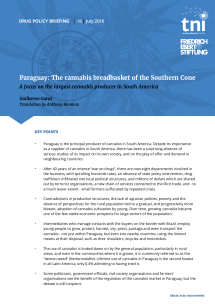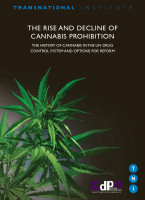Paraguay: The cannabis breadbasket of the Southern Cone A focus on the largest cannabis producer in South America
Regions
Paraguay is the principal producer of cannabis in South America. Despite its importance as a supplier of cannabis in South America, there has been a surprising absence of serious studies of its impact on its own society, and on the play of offer and demand in neighbouring countries.

Downloads
Authors
The history of Paraguay in the import/export and processing of illicit drugs, together with the growing and exportation of cannabis, goes back to the late 1960s, when cannabis growing became established in the department of Amambay, around the town of Pedro Juan Caballero, on the northeastern frontier with Brazil. At the same time venal and cash-hungry central authorities discovered that this trade allowed them to finance a corrupt local political structure, heavily dependent on illegal cash flows and closely tied to the pre-existing caudillo system.
The 1960s and 1970s witnessed the take-off of mafia-style, drug-trafficking organizations in Paraguay. This model was supported by a growing regional demand for cannabis, while criminal enterprises benefited from the northeastwards expansion of the agricultural frontier, the creation of new roads from Asuncion to Brazil, and Brazilian immigration into the departments of Concepción, Amambay, Canindeyú and Alto Paraná. The “brasiguayos”, as the immigrants are called in this region of Paraguay, benefited from agricultural credits, cheap local labour costs, a lack of workplace regulations, and a pervasive absence of the State.
The departments of San Pedro, Alto Paraná, Canindeyú y Concepción - all on the frontier with Brazil - are thus directly influenced by drug traffickers who operate with absolute impunity, drawing into their net both local authorities (mayors, parliamentarians, civil servants, police and military personnel), as well as the business people who articulate the production of cannabis and the triangular trade in cocaine from Bolivia to European and South American markets. Furthermore, they also manage a powerful, hidden network of money laundering.
Landowners, transport workers, hired assassins and private security firms, middlemen who protect growing areas and landing strips, among others, have created an integrated production chain which according to SENAD accounts for 800 million USD in cocaine movements alone. Estimates of the local marihuana crop, carried out in the context of the present study, allow for a further 709.5 million USD in cannabis exports. Added together, these figures closely approximate the 1,594.2 million USD which Paraguay earns from soybeans, its principal legal export.
Forty years ago, cannabis growing was a well-hidden, relatively minor occupation in the two departments of Amambay and Alto Parana. After 40 years of an intense “war on drugs”, there are now eight departments involved in the business, with spiraling homicide rates, an absence of state policy intervention, drug traffickers infiltrated into local political structures, and millions of dollars which are shared out by terrorist organizations, a new chain of services connected to the illicit trade, and - to a much lesser extent - small farmers suffocated by repeated crises.
The chain of drug trafficking has evolved considerably from the amateurish structures of the 1960s, and has taken root within the state. The real question is what will happen next. Will Paraguay continue increasing the violence on its civilian population and with it the number of murders and forced disappearances? The most optimistic scenario is that a discussion about some form of legal regulation will move the debate forward, for without this, the prevailing structures of poverty and inequality will only continue to feed into present levels of corruption, money laundering and illicit trafficking.
Key Points
- Paraguay is the principal producer of cannabis in South America. Despite its importance as a supplier of cannabis in South America, there has been a surprising absence of serious studies of its impact on its own society, and on the play of offer and demand in neighbouring countries.
- After 40 years of an intense “war on drugs”, there are now eight departments involved in the business, with spiralling homicide rates, an absence of state policy intervention, drug traffickers infiltrated into local political structures, and millions of dollars which are shared out by terrorist organizations, a new chain of services connected to the illicit trade, and - to a much lesser extent - small farmers suffocated by repeated crises.
- Contradictions in productive structures, the lack of agrarian policies, poverty and the absence of perspectives for the rural population led to a gradual, and progressively more blatant, adoption of cannabis cultivation by young. Over time, growing cannabis became one of the few viable economic prospects for large sectors of the population.
- Intermediaries who manage contacts with the buyers on the border with Brazil, employ young people to grow, protect, harvest, dry, press, package and even transport the cannabis - not just within Paraguay, but even into nearby countries, using the limited means at their disposal, such as their shoulders, bicycles and motorbikes.
- The use of cannabis is looked down on by the general population, particularly in rural areas, and even in the communities where it is grown, it is commonly referred to as the “demon weed” (hierba maldita). Lifetime use of cannabis in Paraguay is the second lowest in all Latin America, only 0.4% admitting to having tried it.
- Some politicians, government officials, civil society organisations and farmers’ organisations see the benefit of the regulation of the cannabis market in Paraguay, but the debate is still incipient.


